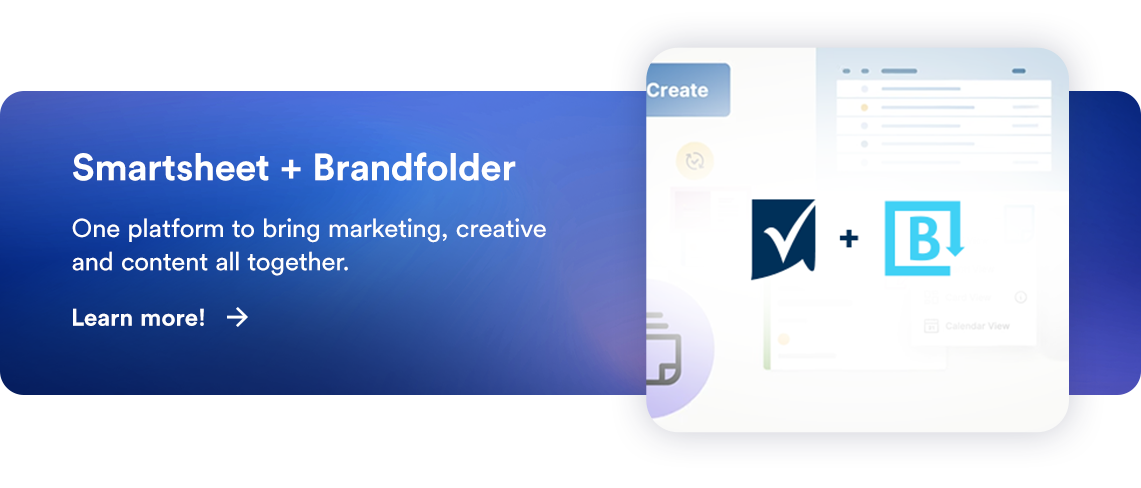- What Is a Brand Brief?
- Why Write a Brand Brief?
- Who Writes a Brand Brief?
- What Does a Brand Brief Include?
- What to Include in a Project-Based Brand Brief
- How to Tell the Difference Between Brand Briefs
- How to Write a Brand Brief
- Brand Brief Examples
- Brand Brief Example Template
- How to Write a Branding Project Brief
- Branding Project Brief Example Template
- How to Write a Brand Identity Brief
- Brand Identity Brief Example Template
- How to Write a Brand Creative Brief
- Brand Creative Brief Template
- How to Write a Brand Design Brief
- Brand Design Brief Example Template
- Blank Brand Design Brief Template
- Mini Brief
- How Different Departments Use a Brand Brief
- Final Thoughts
Get branding tips and expert advice delivered straight to your inbox.
Learn the ins and outs of a brand brief and how to effectively communicate your brand strategy. Find expert tips, and free templates and examples to jump-start your next project.
Included in this blog post, you’ll learn what to include in a brand brief and the difference between branding brief types, and find examples of how to write a brand brief, brand identity brief, brand creative brief, brand project brief, and brand design brief.
What Is a Brand Brief?
A brand brief is a comprehensive document that outlines a brand’s long-term strategy. The brief defines the brand, including its purpose, values, and position. A business uses the brief as a reference to ensure brand consistency.
A company creates a brand brief, also called a brand architecture or brand strategy roadmap, to maintain consistent brand messaging over its long-term strategy. This document is essential for developing and managing a brand’s perceived value, or brand equity, in the eyes of its consumers. By consistently delivering on your brand’s promise with every consumer interaction, you will grow the brand's value. Your brand brief helps to ensure this consistency, no matter which employees or company representatives are involved in the branding activities.
Once the brand manager or larger brand team develops a brand strategy, they create a brand brief to capture the brand’s strategic direction and specifications, which can chart a course for the next three to five years. Essentially, the brand brief informs new teams on the agreed-upon standards and expectations of the brand.
Why Write a Brand Brief?
Writing a brand brief clarifies your brand's strategy and communicates its unique qualities. The brief is a guide for acquainting employees with your brand. Briefs reduce potential damage to your brand's value by helping you consistently communicate brand elements between teams.
Because so many people across a company (and external agencies) are involved in developing, delivering, and communicating the brand, it’s easy to lose focus. However, standing out in today’s market demands brand clarity, and any potential loss of brand focus is costly. Additionally, the brand brief helps inexperienced teams create a brand language that is consistent and distinct, avoiding the common pitfalls of a brand being too vague or overly detailed. Using a structured framework provides the necessary information to avoid watering down important details or leaving too much room for interpretation. A highly focused brand is essential for the brand to stand out among competitors.
A brand brief can minimize these costs by aligning your people to the brand before you begin to work on a project. The brief onboards employees to a common brand language, provides guidelines for how they can embody the brand in their work, develops a self-regulating team, and keeps creative efforts on brand within the given constraints.
In addition, the brand brief helps to do the following:
Reduce Consumer Assumptions: Regardless of a company’s popularity, it is easy for consumers to assume they know everything about the brand’s identity. Without a brand brief, creative teams and marketing professionals can build campaigns and designs that deteriorate the clarity of the brand’s messaging. This leads to consumers filling in the gaps on their own, giving the company less control over the brand’s perceived identity.
Create a Shared Understanding: Confusion often arises from poor communication in projects. You’ll remove future frustration around branding by taking the time to align the team to its larger purpose and define the brand using a brand brief at the outset.
Deliver on Long-Term Strategy: Strategic directions can quickly shift without intention once activities begin. A north star — in this case, the brand brief — helps the brand to follow its initial direction.
Align Your People: Any person new to the brand will need onboarding, and a brand brief is essential to the orientation process. The brief provides a common ground for creative problem solving within the brand’s style and serves as a resource to work through differing directional ideas.
The longevity of your brand relies on its consistency. Kevin McTigue, the co-author of The Creative Brief Blueprint and a professor at the Kellogg Business School at Northwestern University, highlights the importance of using a brand architecture to deliver brand consistency. “Good brands are consistent,” he says. “Good brands, every time you run into them, are familiar. They reinforce the same elements; otherwise, [the brand message is] lost on consumers. By documenting the important elements of your brand, you help your brand remain consistent over time.”
Graham Robertson, Founder of Beloved Brands, says, “A lot of times, we think briefs are to inspire creative people, but they are to remind yourself of the bigger purpose and to shift your brain. [A brand brief] also helps to control the strategy, not only in the project, but also with your boss. This helps to increase the chances of your branding project’s approval.”
Graham uses the brand strategy roadmap as an organizing tool and views it as the biggest idea that steers everyone. “[A brand brief] has the most macro-level views of the vision, purpose, values, and the brand articulated in five different touchpoints: promise, story, purchase moment, innovation, and consumer experience,” he says.
Because the concept of brand has become so nuanced, these touchpoints ensure that your brand message is consistent, regardless of the consumer’s entry point or interaction with the brand. “You don’t know which [touchpoint] the customer will see first. Life would be easy if it were how it used to be — you see an ad, go to the store, buy the item, use it, are happy, repeat. Now, we don’t know which touchpoint the customer will see first. Media choice is such a cluttered mess, with 5,000 brand messages a day on average. Brand messages are everywhere, all over the place, with so much marketing. Consolidate your message to make sure it is focused and stands out.”
Who Writes a Brand Brief?
The branding or marketing manager is primarily responsible for developing the brand brief. Because the brand brief will be in effect for three to five years, you’ll likely have several thoughtful conversations about lasting brand strategy before documenting it.
In a larger company, the manager may lead the team to develop a brand strategy, and then work with a team to create the brand brief. In a smaller company or startup, the brand strategy and brand brief may fall on one individual, most likely the founder, CEO, or business owner. The length of a brand brief can range from one page to an entire book, depending on the size or strategic approach of the company.
Regardless of who is writing the brand brief, the goal is to create a clear document for any internal audience to refer to over the long term. Consider the various ways that in-house teams, departments, management, and external agencies will use the comprehensive brief.
Those likely to refer to your brand brief include the following:
- Ad agencies
- Company culture teams/human resources
- Creative teams
- Customer experience teams
- Department heads and key management
- Design teams
- Fundraising/development teams
- Marketing departments
- Product teams
Additionally, consider the perspectives of those responsible for positively impacting and perpetuating your brand image, such as public-facing leadership, department heads, influencers, and brand partnerships. Take time to know how each department uses the brand, and work with department management to know what they need to support their team's role for the company's branding efforts. These discussions will also influence how you develop the branding strategy.
Your company may already have a brand brief in place. In this case, you may only need to revise it. A brand brief rebrand is ideal for existing companies looking to shift or update their brand’s strategic vision or for external agencies assisting with a company’s rebranding efforts.
In most other cases, you’ll need to develop a new brand brief. This route is ideal for new companies or startups that lack any formal brand concept, newer businesses with amateur brand strategy that need formal guidelines in order to reach growth goals, or specific departments that want to create or strengthen a strategic vision that aligns with the company’s larger brand strategy.
What Does a Brand Brief Include?
A brand brief includes all elements that help deliver the brand’s core strategy, including the brand’s purpose, objective, profile, personality, positioning, brand assets, brand guidelines, and any added information specific to the brief needs.
These elements are described in detail as follows:
- Brand Profile: The brand profile includes the purpose, mission or vision, brand story, core values, and brand promise.
- Brand Objective: This is the image you want your brand to convey, the culture your brand cultivates, and the goals of your brand message.
- Client Information: This includes your and your client’s contact information.
- Positioning: This is your brand’s value proposition, target audience, and market segment, as well as any key competitors and your competitive advantage in your market.
- Branding Guidelines: Describe the tone, personality characteristics, colors, voice, imagery, and anything else associated with the brand that makes you stand out from competitors. Avoid trends that will quickly pass.
Overall, a brand brief includes the key items listed above to deliver the brand’s core strategy. If you’re creating a brand brief for a specific project, you should also include the details mentioned in the section below.
What to Include in a Project-Based Brand Brief
A project-based brand brief, such as a brand creative brief or brand design brief, is tailored to the goals of the project or campaign, but still align with the overall brand brief.
Include the following elements in a project-based brief:
Expected Deliverables: Detail the end result(s) of the project, including whether the product is digital or physical, the technical requirements, and any specifications for the designers.
Brand Campaign Message: Describe the messaging strategy attached to the project. You may include sample brand campaigns or previous projects as a reference.
Design or Project Elements: Include an overview of the design elements and objectives (essentially, the creative details), such as the placement of the logo on physical products.
Marketing Materials: Note any details about the required materials, as well as the brand promotion efforts, such as ad copy or print campaigns.
Competitive Analysis: Include any research on competitors that contributes to the project campaign strategy.
Schedule: Note any deadlines and benchmarks you will measure project progress against. Ensure that the timeline is realistic.
Campaign Needs: Detail the objective of the campaign and any additional requirements.
As Kevin McTigue says, “Whether it’s brand or creative, the brief must identify an objective, as well as growth, positioning, executional and mandatory details, and measurement.” McTigue offers the following recommendations for what to include in your project brand brief:
An Objective: From the get-go, label the project or brand goal to ensure you know the direction you’re headed.
Growth: Identify how your project will achieve its intended growth via its branding. You can do this by determining your most valuable customer and what they find meaningful. This step may take the most time, but it will help you to prioritize how you use your resources.
Positioning: Determine who your project’s brand is for and why it is superior to competitors. Be clear about why your customers choose your brand. Once you’ve intentionally taken the time to pinpoint your unique value proposition, identify the ways that your long-term brand brief will continually reinforce this brand message.
Executional and Mandatory Details: Claim your core elements, or the consistent cues that make your brand feel familiar. Look beyond the obvious elements (logo or tagline) and include details that make your brand interesting (i.e., color palette, style, audio cues, photo aesthetics). Using consistent elements across touchpoints gives you the most advantage for consumers to fully process your brand.
Measurement: Track success accurately by developing the criteria early. Use these data and feedback loops to shift direction strategically and improve your brand’s delivery.
Taking the time to map out the direction of your project will help you get the end results you want.
How to Tell the Difference Between Brand Briefs
A brand brief defines and communicates your strategic roadmap, but does not include a budget, schedule, or specifics. Project-based briefs align strategically with the larger brief, and also include campaign specifics, like timeline, budget, and deliverable specifications.
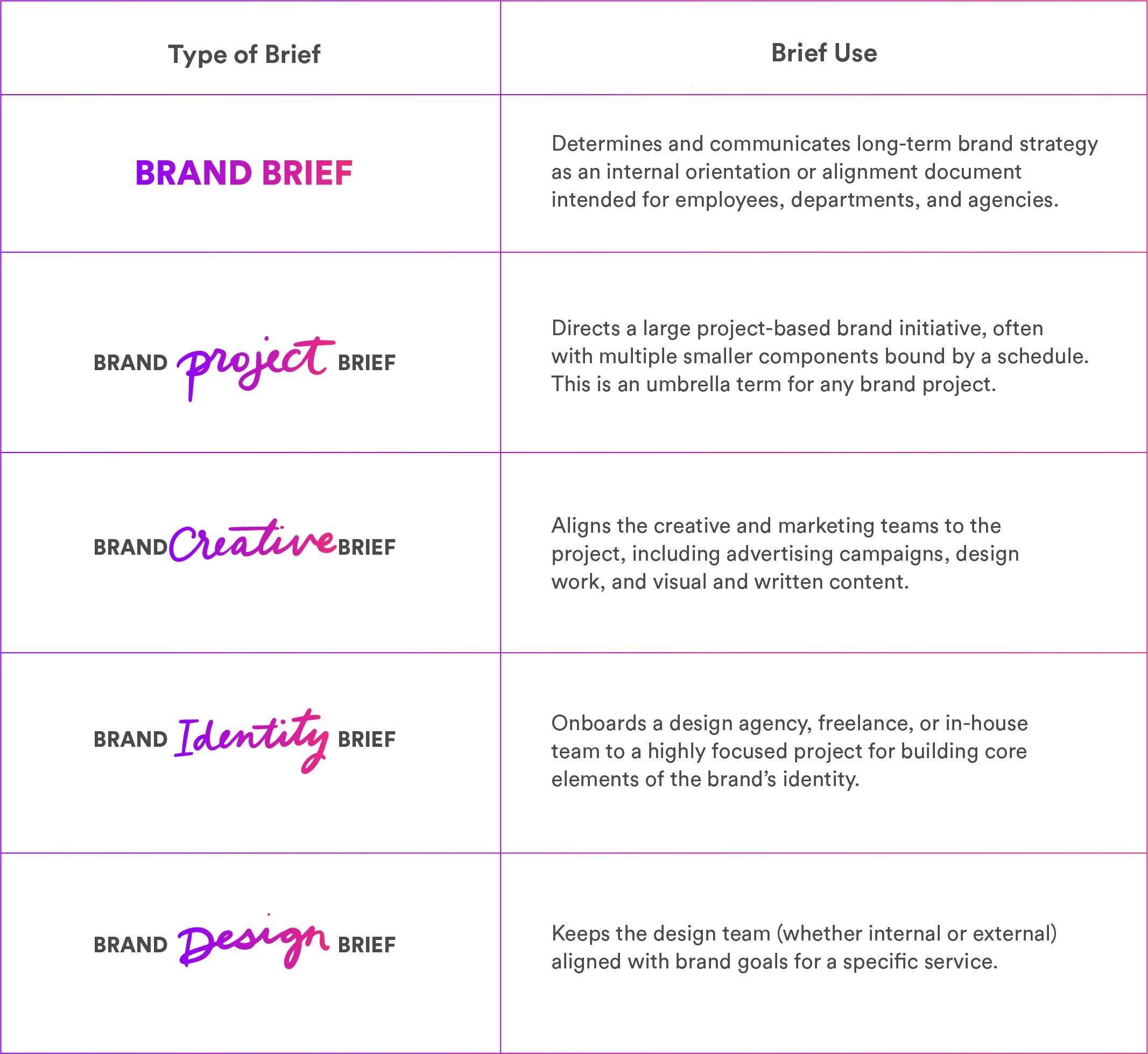
Brand Brief vs. Project or Creative Brief
The brand brief focuses primarily on large-picture strategy, while other briefs are project-based and simply draw elements from the larger brand strategy.
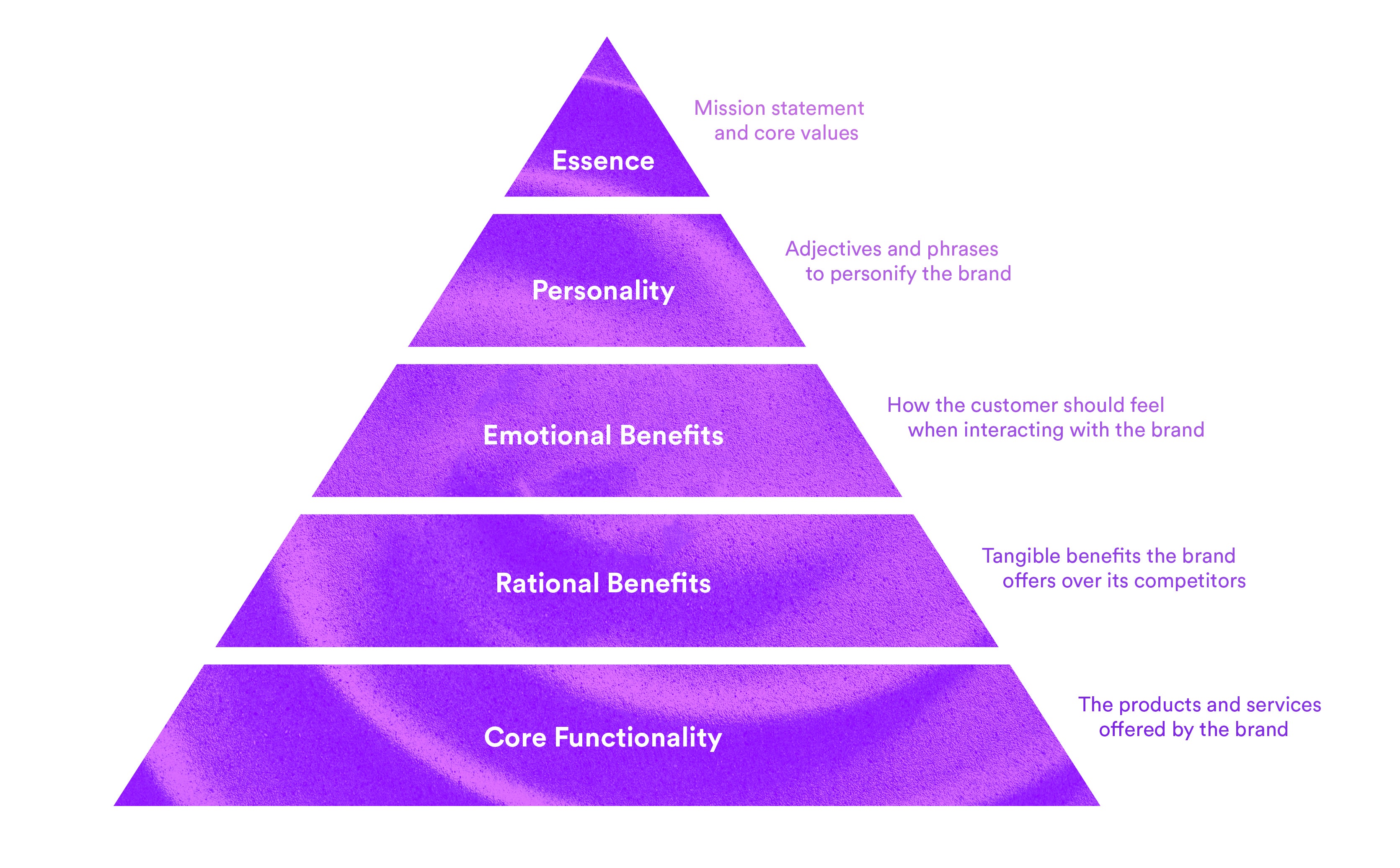
How to Write a Brand Brief
Writing a brand brief takes five steps: select your brand strategy framework; assess your existing brand; determine your brand strategy; prepare your brand brief; distribute your brand brief. Each step is detailed below:
1. Select Your Brand Strategy Framework
Use an existing strategic framework, such as brand pillars, to determine your brand’s strategic direction. A solid brand strategy framework will help you and your team discover the following aspects of your brand:
Purpose: The purpose is why your brand exists and what difference it will make for your customers. To define your purpose, you must articulate the mission, vision, and values that define the company culture through every action.
Position: This refers to the market in which your brand will compete and the customer segment you are targeting. Detail your value proposition for your customers, and include a competitive analysis to discover insights and gaps in the market that influence your position.
Promise: This is what customers expect each and every time they interact with your brand. Describe how you will deliver on that promise.
Personality and Promotion: Complete this step to personify your brand and describe how it will behave. This exercise will help you to determine the creative aspects of how to present your brand to the world.
2. Assess Your Existing Brand
If you are working with an existing brand, perform a brand audit to understand your current position in the market and its relevance.
3. Determine Your Brand Strategy
Using the strategic framework from step one, schedule time for yourself (or with your team and stakeholders) to walk through each exercise to determine your strategic direction. This step will take the most time — it is a thorough process in which you determine how you stand out among competitors and your approach to claiming space within the market. Complete the brand brief template as your team identifies the most direct strategic approach.
Expert Tips Graham’s Robertson’s comprehensive tips, listed below, focus on positioning and strategy development in two phases.
Phase 1: Start with your positioning, including the functional and emotional benefits necessary for this position. He suggests, “Write an example positioning statement to test against customers’ or your own judgment. From these, determine which statements are the most motivating for customers” to help see which statements are the best to move them to make a purchase. Finish your positioning work by summarizing the top statements with a brand idea, also known as a seven-second pitch.
Phase 2: Develop your strategic vision. He shares that this vision needs to be “what perfection will look like in seven to nine years.” Your strategy is created by identifying the key issues it takes to achieve this vision and assessing what you currently have and will need to reach it. Your strategy starts to take shape from these identified gaps and question responses on how to reach your goal.
4. Prepare Your Brand Brief
Once you’ve developed a strategy, it’s time to develop a brand brief framework, which will serve as the architecture or roadmap for anything brand-related. You can also use one of our existing brand brief templates and easily share it with the necessary teams.
5. Distribute Your Brand Brief
Communication is essential to align all team members (internal and external) to the new messaging. Internally, educate your employees on any changes or updates you make to the messaging. Be sure to share the brief with all departments in the organization, including HR, sales, and finance, to cultivate employees as brand ambassadors. Use the brand brief as the foundational document that informs any project-based brand briefs, as the creative team and key management work to deliver on the brand’s strategic elements.
Next Steps: Communicate Your Brand
Develop the strategic direction of communicating the brand to consumers. First, build a brand communication strategy, and then create a detailed brand communication plan to organize and raise brand awareness through messaging campaigns. The communication plan will help guide the schedule and control circulation projects to meet long-term objectives.
Brand Brief Examples
In this section, you’ll find a variety of brand brief examples that show the difference among each type. The section covers brand project briefs, brand identity briefs, brand creative briefs, and brand design briefs.
Brand Brief Example Template
You can use this completed brand brief template as an example of how to communicate your brand strategy with any team. This dynamic, reusable brand brief template allows you to easily track the crucial details of effective brand development with the guidance offered by the sample text. Ensure that your client and brand-team members remain apprised of all brand-specific developments — from initial brainstorming stages to announcing and launching your brand. Additional sections include details for further brand clarification (e.g., brand tone, brand personality, key brand takeaway, and tagline).
For a variety of other brand brief templates, visit our comprehensive template roundup
How to Write a Branding Project Brief
A branding project brief is an actionable brief for general branding projects. In contrast to a brand brief, it specifies the needs of a particular project or campaign to share with the relevant team members. Use the flexibility of a branding project brief to guide your team and describe the details of a specialized or long-term project.
Branding Project Brief Example Template
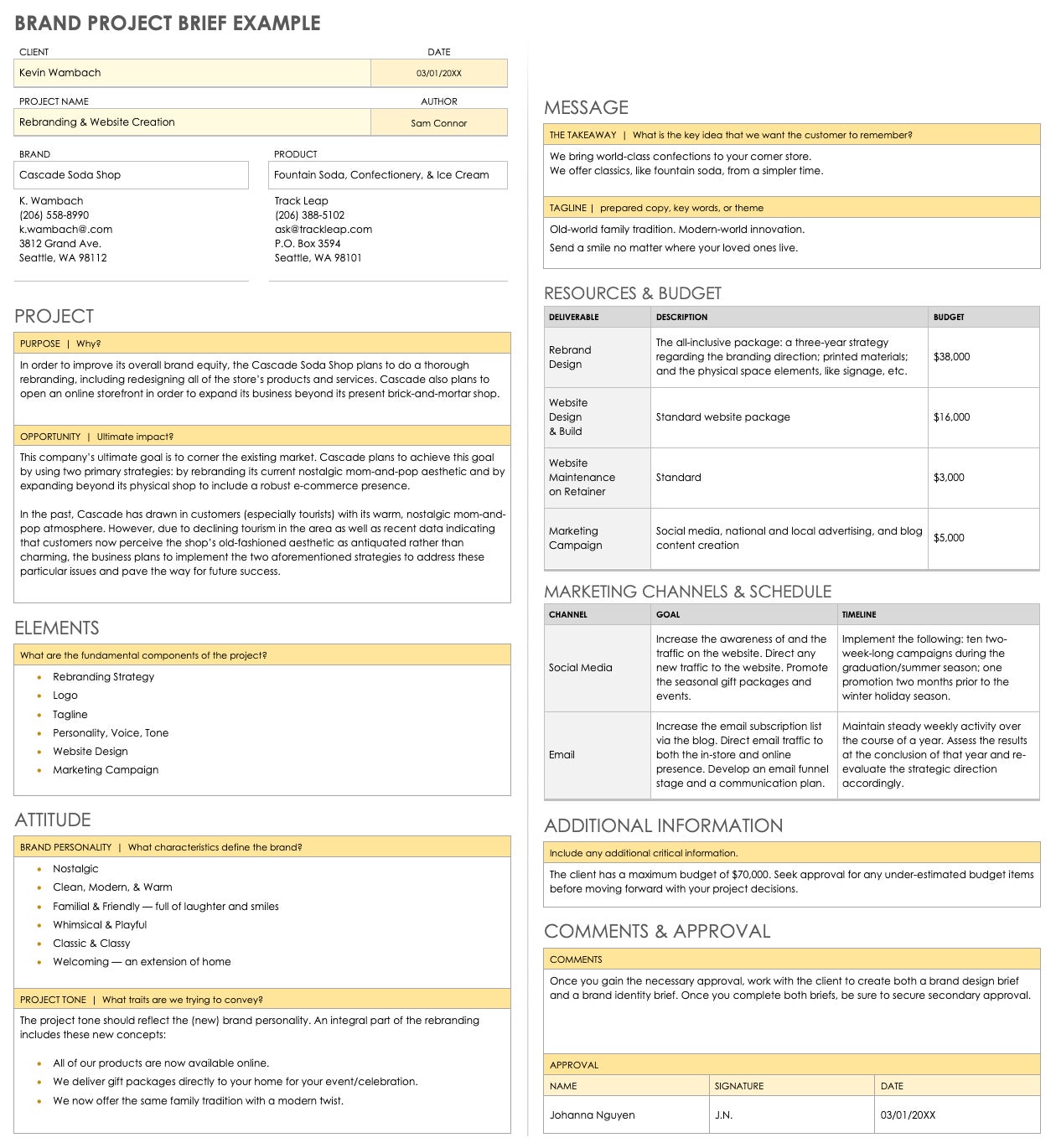
Use this completely customizable branding project brief example template to help your team successfully deliver its next branding project.
How to Write a Brand Identity Brief
A brand identity brief helps your creative and marketing teams pinpoint your brand’s identity in order to build a sound campaign from start to finish. First, refine your brand’s top qualities and characteristics by analyzing the competition and answering prompts to develop your brand’s personality. Then, communicate your brand identity through a specific campaign for a targeted audience.
Brand Identity Brief Example Template
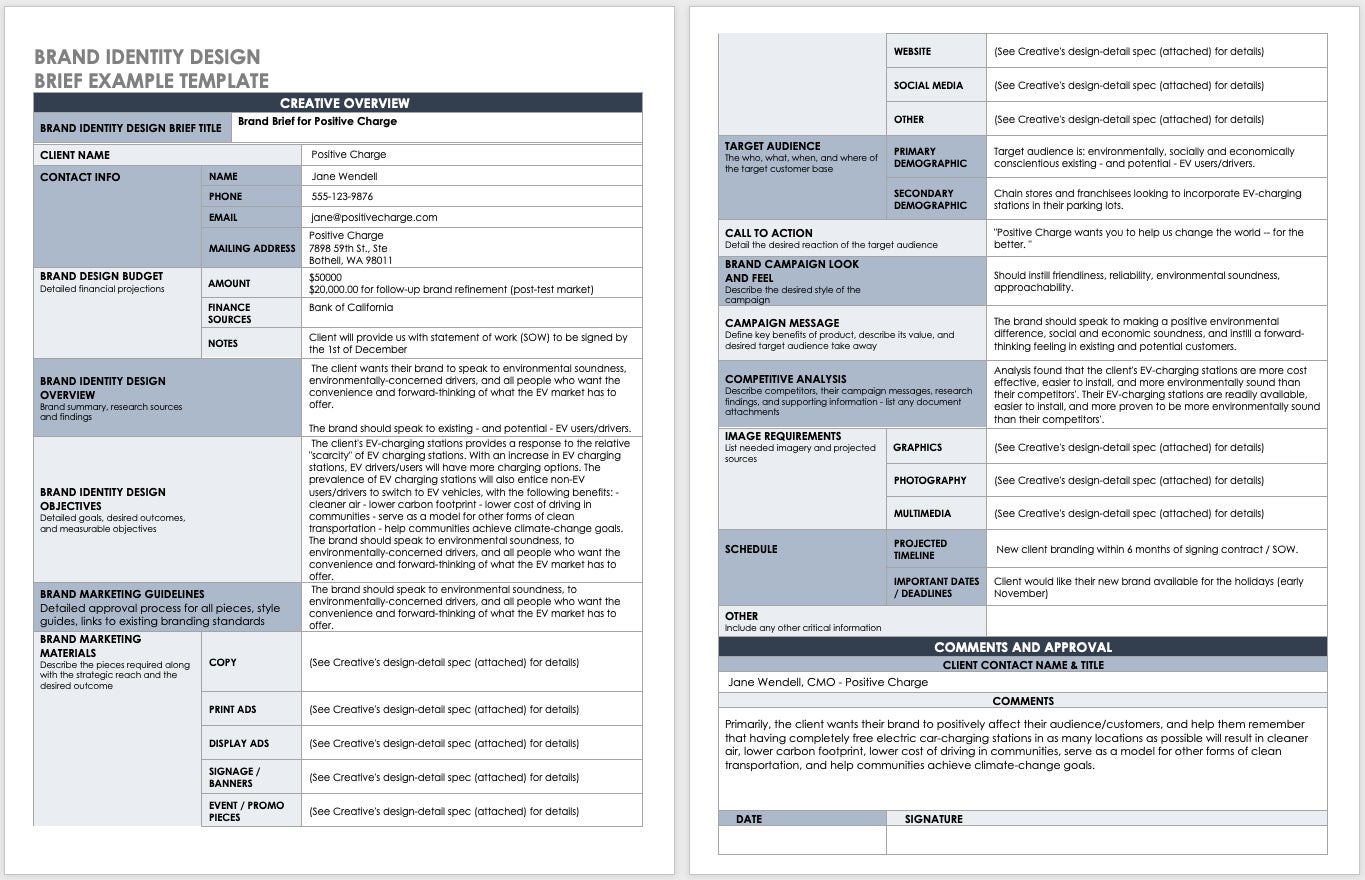
This customizable brand identity design brief example template includes objectives, design budgeting, campaign details, and marketing guidelines to keep your team informed and on track. This template also helps you drill down into brand-related specifics, including brand image requirements and branding schedule, to ensure that you account for all branding aspects and are on track for launch.
You can also download a fully editable brand identity brief template as a client intake form or complete the template for your in-house team.
How to Write a Brand Creative Brief
A brand creative brief outlines your project’s details, including the brand strategy, objectives, goals, and other pertinent info that sets your creative project aside from the competition. The brand creative brief focuses on any designated creative project to keep it in line with your brand strategy. In the creative brief, include your target audience and brand personality, as well as the ways your brand personality will be used in this specific project to reach your target audience.
Brand Creative Brief Template
Use this brand creative brief template to focus your creative ideas without losing sight of project goals during the planning process. The template includes space to list the project purpose, opportunity, elements, objective, target audience, tone, personality, customer takeaway, and messaging tagline.
How to Write a Brand Design Brief
A brand design brief focuses on a specific design project. It helps the designers understand the client’s goals for the design project and clarifies specific campaign needs associated with the designed item(s).
Brand Design Brief Example Template

Download a customizable brand design brief example template as a tool to outline your business goals, detail your brand’s qualities, and to deliver on key business opportunities.
Blank Brand Design Brief Template
Alternatively, you can start fresh by downloading a blank brand design brief template, which is entirely editable and can be adjusted to meet your design campaign needs. Use this one-of-a-kind planner to help account for all key brand-design components and associated business goals from your brainstorming stage. Then you can deliver your well-planned and dynamically designed brand to market quickly.
Mini Brief
In the past, branding campaigns may have lasted between three and six months to prepare and run. But in today’s fast-paced digital market, digital marketing campaigns may only be relevant for a few hours before the launch.
Graham Robertson has developed the mini brief as a solution to a quick-turnaround project: “[Even] if you only have four hours, [filling out a mini brief] will still save you time. Take 20 minutes to write a brand brief. Because if your boss doesn’t know what you’re talking about, your project is dead and won’t be approved.”
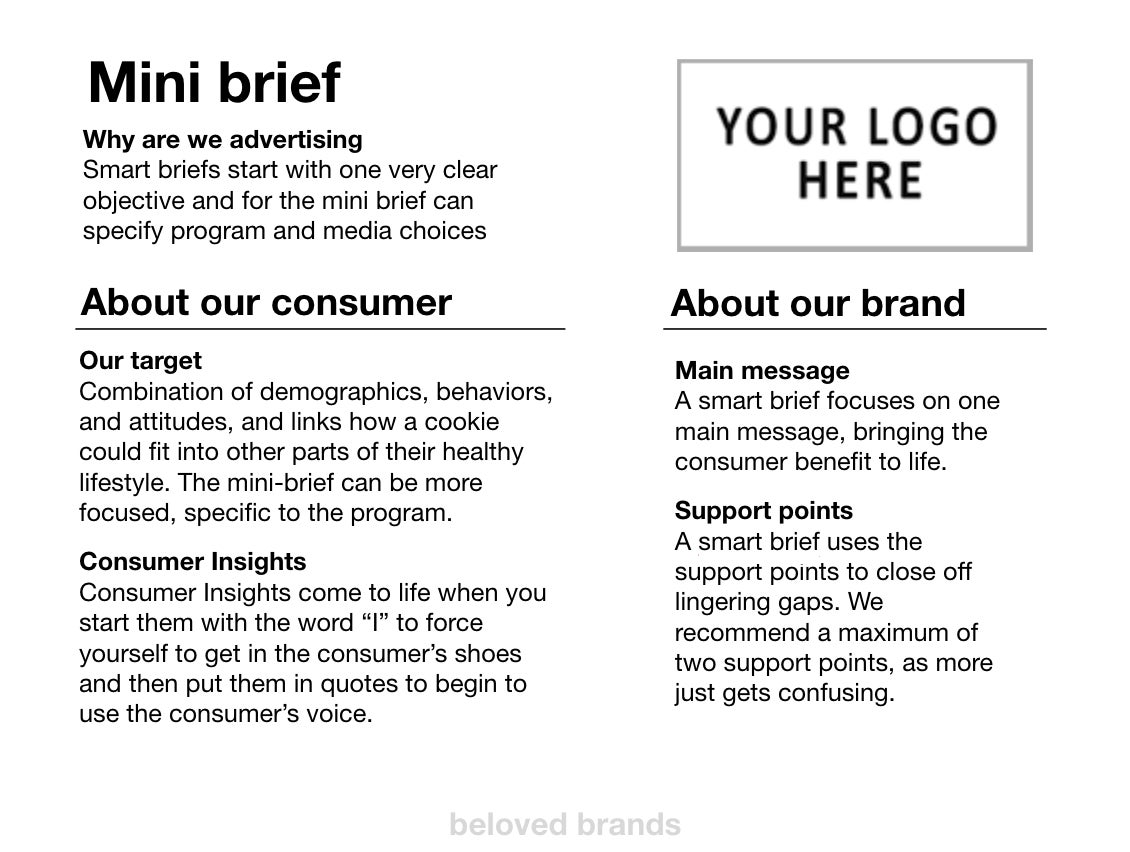
How Different Departments Use a Brand Brief
A brand brief is helpful when developing culture and relationships in any department. The marketing and creative teams are the main departments involved with branding. Other departments use the brief to stay on-brand with clients, employees, and stakeholders.
The brand brief is a high-level, strategic guiding document for the entire organization. A brand increases its strength if the interactions within the company culture reflect the brand values. The brand brief informs departments in different ways to align teams as they learn about and live out the company mission, vision, and purpose:
Marketing: The marketing department is the most visible and active team when using a brand brief. It is responsible for developing and managing campaigns that promote the brand through messaging. In addition, the brand brief supports smaller, short-term campaign projects. Because each company organizes its marketing team structure differently, the creative team may also be part of the marketing department.
Ad Agency: Some companies prefer to hire external teams, such as ad agencies, to run their ad campaigns. Depending on the ad agency, you might use an existing brand brief form, or they might request you provide your brand brief. Consultants from the ad agency work with the branding manager, and communicate through brand briefs to develop and deliver successful ad campaigns.
Design Agency: Similarly, companies may hire a design agency to create the brand’s visual elements. A brand brief is necessary for the design team to understand you as a client and communicate your business’s needs.
Sales: As the public face of the company, sales employees are crucial in delivering the brand’s message as they develop relationships with existing and prospective customers. The brief also is a talking point for the sales team as they address customer challenges. The team uses the brief to support company values and ethics during conversations. Additionally, the sales department must align with the brand to set sales targets and tactics to grow the company through the brand.
Human Resources: The HR department aligns new hires to the brand during onboarding and develops a shared understanding from an employee’s first day.
Finance: Finance employees working with shareholders use messaging of the brand promise to build confidence, reliance, and trust with shareholders. Account managers showcase the target audience and strategic goals to demonstrate how the company delivers on its promise.
Final Thoughts
Like anything in life, preparing and planning ahead of time tends to make all the difference — including taking the time to create solid direction for your brand projects. Follow the steps above to write your brand briefs, project briefs, brand identity briefs, brand design briefs, and creative briefs. When written properly, a solid brief has the ability to yield impactful results. And, don’t forget to make use of the templates and resources we’ve provided to guide you through your journey.
Need more inspiration? Check out our free ebook on “How to maintain creative control.”


